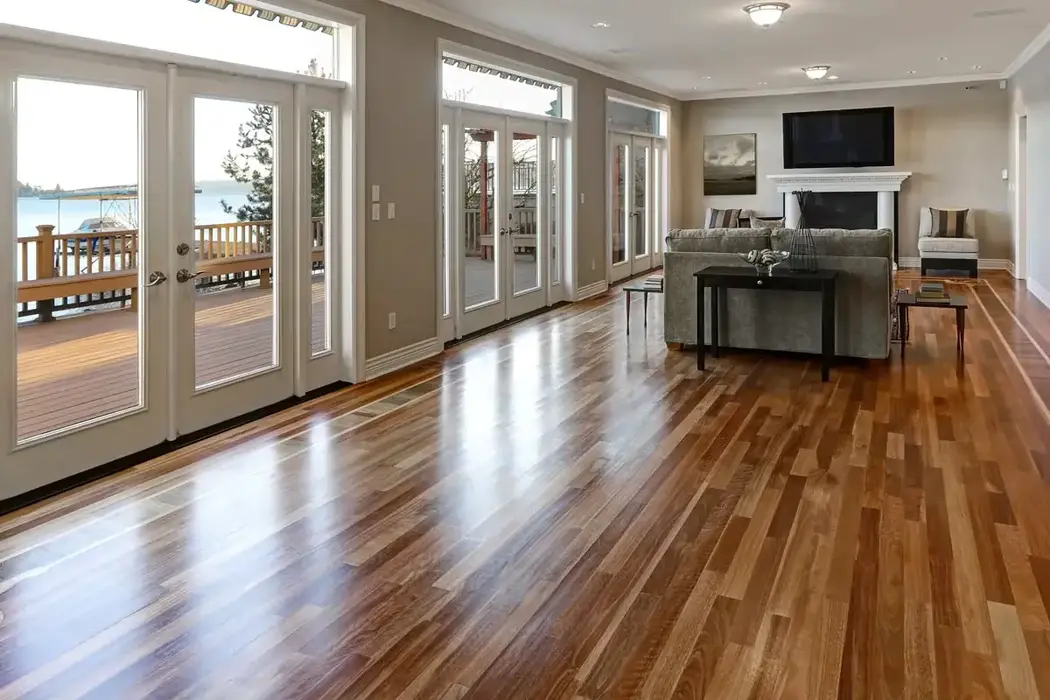

Laminate flooring has a core made of high-density fiberboard (HDF), covered with a photographic layer that looks like wood or stone, and finished with a clear protective layer.
It typically consists of four main layers:
1. Wear Layer: A clear, protective layer that provides resistance to scratches and stains.
2. Design Layer: A high-resolution photographic image that mimics the appearance of wood, stone, or tile.
3. Core Layer: Made of high-density fiberboard (HDF) or medium-density fiberboard (MDF), providing stability and durability.
4. Backing Layer: A moisture-resistant layer that provides balance and prevents warping.
This layered structure makes it durable, resistant to daily wear and tear and can withstand heavy foot traffic.
Laminate flooring is also easier to clean and maintain compared to many other flooring types.
Additionally, its construction makes it more resistant to moisture and temperature changes, reducing the risk of warping or expansion.
Reading homeowners can choose from several types of laminate flooring:
This popular option replicates various wood species and finishes like rustic oak and sleek mahogany. It's great for those who want the warmth of wood but need something more durable and affordable.
Stone-look laminate mimics the appearance of natural stone such as marble, slate, and travertine. It offers the elegant look of stone flooring without the high cost and maintenance.
Tile-look laminate looks like ceramic or porcelain tiles, offering a sleek and modern look. It's ideal for kitchens and bathrooms where you want the appearance of tiles without the cold, hard surface.
High-gloss laminate has a shiny, reflective surface that can make spaces look larger and brighter. This type is perfect for creating a modern and luxurious feel in any room.
Installing laminate flooring can be a DIY project for handy homeowners, but a professional installation is also an option. Here's an overview of the installation process:
1. Acclimate the flooring: Allow the laminate planks to acclimate to the room’s temperature and humidity for 48 hours before installation. This process helps prevent expansion or contraction after installation.
2. Prepare the Subfloor: Ensure the subfloor is clean, dry, and level. Remove any existing flooring if necessary.
3. Measure and Plan: Measure the square footage of the room to estimate the amount of laminate you need.
Decide on the direction in which the planks will be laid. Usually, running parallel to the longest wall or the main light source is best.
Pan around doorways, vents, and other obstacles to ensure a seamless installation.
1. Install the underlayment: Roll out the underlayment across the subfloor. As you lay, make sure to overlap the seams and secure them with tape.
2. Lay the First Row: Place the first row of planks along the longest wall, and use spacers to maintain an expansion gap (usually 1/4 inch). This gap allows the flooring to expand and contract with changes in temperature and humidity.
3. Click and Lock: Align the tongue of the new plank with the groove of the previously laid plank at a slight angle, then press down to lock them together. Use a tapping block and rubber mallet to secure the connection if needed.
4. Stagger the Joints: Start the next row with a plank cut to at least 1/3 of its length to stagger the joints. This adds strength and a more natural look to the floor. Repeat this process for the next set of planks.
5. Install Trim and Moldings: After completing the installation, remove the spacers from the edges to cover the expansion gap. Trim any excess underlayment around the edges of the room and install baseboards or quarter-round moldings to cover the expansion gaps around the room's perimeter. Secure them to the wall, not the floor, to allow for movement.
With so many options available, choosing the perfect laminate flooring for your home can be a bit overwhelming. Here are important factors to consider to help you select the best flooring that meets your needs and complements your space.
The AC (Abrasion Criteria) rating indicates the durability of the flooring. For residential use, look for AC3 or AC4 ratings. High-traffic areas, such as hallways or living rooms, may benefit from AC4 or even AC5-rated products. These ratings indicate how well the flooring can withstand daily wear and tear.
Thicker laminate flooring (12mm or more) is generally more durable and provides a feel similar to real wood underfoot.
Thinner options (7-8mm) can still be suitable for bedrooms or home offices. The thickness also contributes to the sound insulation and overall comfort of the flooring.
While laminate flooring is not completely waterproof, many options offer good moisture resistance. This feature is crucial for areas like kitchens, bathrooms, or basements.
Look for laminate flooring with water-resistant cores and tight locking systems to prevent moisture damage.
Choose a style that complements your home's décor. Laminate flooring comes in various designs, and the right style can enhance the overall look and feel of your space.
Laminate flooring varies in price. Set a budget, but remember that investing in higher-quality laminate can save money in the long run due to increased durability.
For some of the best laminate flooring options in Reading, visit My Dad’s Flooring.
We partner with reputable brands to bring you a wide selection of high-quality laminate flooring options.
Our extensive selection includes various styles, colors, and finishes, and we guide you through the process of choosing the perfect laminate flooring for your home or business.
Visit our store or contact us to get yours.